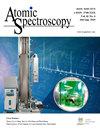Accurate analysis of Fe isotopes in Fe- dominated minerals by excimer laser ablation MC-ICP-MS on wet plasma conditions
IF 2.3
2区 化学
Q1 SPECTROSCOPY
引用次数: 7
Abstract
The Fe isotope ratios can be a useful tracer of geochemistry, biogeochemistry, and the environmental redox state. In this study, we investigated the feasibility of Fe isotopic analysis in Fe-dominated minerals by 193 nm excimer ns laser ablation combined with Nu Plasma 1700 high resolution MC-ICP-MS without matrix-match calibration. Several important instrument parameters were investigated, such as the effect of the addition of nitrogen gas and water vapor, the effects of analytical parameters such as ablation mode, laser fluence, pulse repetition rate, spot size on Fe isotopic mass bias during analysis were investigated as well. The results showed that the effects of ablation mode, spot size, laser pulse repetition rate, and line scan speed can be neglected, while laser fluence and matrix effects had significant influence on the Fe isotopic mass bias at dry plasma condition. These problems can be minimized using consistent lower fluence (1.5‒3.5 J·cm-2), as well as the wet plasma conditions can significantly reduce the matrix effect in Fe isotopic analysis. Fortunately, with the water vapor and nitrogen gas addition after the ablation cell, an accurate and precise Fe isotope in pyrite, manganite, hematite, and chalcopyrite analysis by ns-LA-MC-ICP-MS can be achieved with non-matrix-matched calibration. The obtained accuracy and reproducibility of the in situ determinations of δ56FeIRMM-014 were both better than ± 0.10‰ (2 SD). This study indicated that there was a serious matrix effect in the Fe isotopic analysis of Fe-dominated minerals by ns- LA-MC-ICP-MS, and nitrogen gas mixed with water vapor-assisted ns- LA-MC-ICP-MS were an appealing option for the in situ Fe isotope analysis of Fe-dominated minerals with non-matrix-matched calibration.湿等离子体条件下准分子激光烧蚀MC-ICP-MS精确分析铁主导矿物中的铁同位素
铁同位素比值可以作为地球化学、生物地球化学和环境氧化还原状态的有用示踪剂。在本研究中,我们研究了在没有矩阵匹配校准的情况下,通过193nm准分子ns激光烧蚀结合Nu Plasma 1700高分辨率MC-ICP-MS对Fe为主的矿物中的Fe同位素进行分析的可行性。研究了一些重要的仪器参数,如氮气和水蒸气的加入的影响,以及烧蚀模式、激光注量、脉冲重复率、光斑大小等分析参数对分析过程中Fe同位素质量偏差的影响。结果表明,在干等离子体条件下,烧蚀模式、光斑大小、激光脉冲重复率和线扫描速度的影响可以忽略,而激光注量和基体效应对Fe同位素质量偏差有显著影响。使用一致的低通量(1.5-3.5 J·cm-2)可以最大限度地减少这些问题,并且湿等离子体条件可以显著降低Fe同位素分析中的基质效应。幸运的是,通过在消融池后添加水蒸气和氮气,可以通过非基质匹配校准实现ns-LA-MC-ICP-MS分析黄铁矿、锰铁矿、赤铁矿和黄铜矿中准确和精确的Fe同位素。δ56FeIRMM-014原位测定的准确度和重现性均优于±0.10‰(2 SD)。本研究表明,ns-LA-MC-ICP-MS对以铁为主的矿物的铁同位素分析存在严重的基质效应,氮气与水蒸气混合辅助ns-LA-MC-ICP-MMS是非基质匹配校准对以铁为主导的矿物进行原位铁同位素分析的一个有吸引力的选择。
本文章由计算机程序翻译,如有差异,请以英文原文为准。
求助全文
约1分钟内获得全文
求助全文
来源期刊

Atomic Spectroscopy
物理-光谱学
CiteScore
5.30
自引率
14.70%
发文量
42
审稿时长
4.5 months
期刊介绍:
The ATOMIC SPECTROSCOPY is a peer-reviewed international journal started in 1962 by Dr. Walter Slavin and now is published by Atomic Spectroscopy Press Limited (ASPL). It is intended for the rapid publication of both original articles and review articles in the fields of AAS, AFS, ICP-OES, ICP-MS, GD-MS, TIMS, SIMS, AMS, LIBS, XRF and related techniques. Manuscripts dealing with (i) instrumentation & fundamentals, (ii) methodology development & applications, and (iii) standard reference materials (SRMs) development can be submitted for publication.
 求助内容:
求助内容: 应助结果提醒方式:
应助结果提醒方式:


